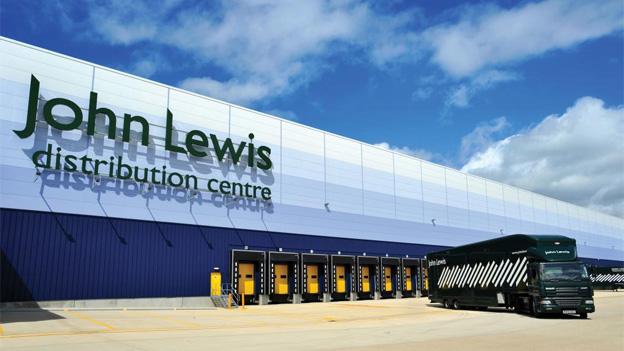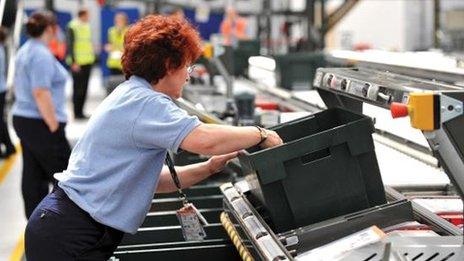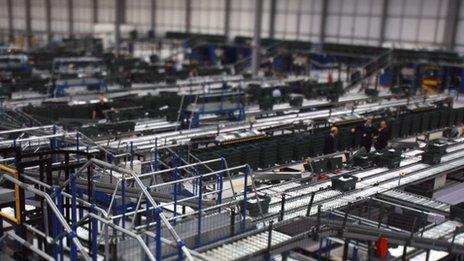The complicated art of retail logistics
- Published

John Lewis's giant distribution centre in Milton Keynes is the size of an airport terminal building
It's almost the season to be jolly interested in how things are selling in the shops.
The news media, both print and broadcasting, seem to think that how retail sales fare over Christmas is as meaningful a part of the festive season as carols and mince pies.
Yet when we eventually get most figures in January, weeks after we all experienced the throes of Christmas shopping, they are hopelessly retrospective.
Only one set of shopping statistics comes out on time. Those are the ones issued by the John Lewis Partnership every week of the year. But of course John Lewis is a worker's co-operative, and the partners need to know in the interests of participatory democracy.
Thinking about John Lewis as the Christmas season looms made me remember an encounter with the company earlier in the year that provided a vivid example of how intertwined are luck and good planning in the running of a flourishing business.
I was visiting the huge John Lewis delivery centre on the outskirts of Milton Keynes, the size not of an aircraft hangar but an airline terminal. It's vast.
As John Lewis's head of distribution centres Terry Murphy showed me round, the complexity of delivery services became more and more obvious... and the reason why they are now called "logistics", rather than simply "transport".
A fascinating story about the history of the distribution centre emerged bit by bit.
E-retailing boom
Some 10 years ago the firm decided to significantly expand by opening 10 new stores in parts of Britain that lacked them. And that meant John Lewis also needed a state-of-the-art warehouse to supply the new stores. They found a site in Milton Keynes and invested £58m in it.

Despite mechanisation, there is still much work for staff to do
Then came the 2008 recession, and John Lewis reviewed its plans. Being a cautious company spending partners' money, it decided to seriously reduce its ambitions. From the plans, only three of the new full-sized stores survived, though it has been opening smaller shops as well.
But that meant a vast new echoing warehouse in Buckinghamshire, hugely over capacity.
The company hung on. Maybe the space would come in useful later.
Well, it did. John Lewis had been predicting a steady expansion of its online retailing, a sideshow to its bricks-and-mortar sales. But in fact, e-retailing began to develop exponentially, even during recession and maybe because of it. In some recent years, it's been up 25% on the previous year.
"Click and Collect" has been particularly successful. Order by 20:00 one day and the purchase will be available for collection from 14:00 the next day at a specified John Lewis or Waitrose store. Quick service without the uncertainty of to-the-home delivery.
This boom is not without its own problems at Milton Keynes. The complex computerised off-the-warehouse-shelf system there was designed to deliver goods to stores so that they were ready for placing directly on the retail shelves.
But e-retailing is a rather different proposition. Fulfilling an ever increasing proportion of online orders demands a different scale of systems thinking, even when the goods themselves are plucked by robots from the warehouse shelves in just the same way.
Instead of delivering boxes to different parts of 40 John Lewis stores, online deliveries may go to any one of millions of UK addresses. plus the Waitrose stores involved in the click and collect service. (They of course have separate supply arrangements for their grocery goods.)
Rapid delivery needs a meticulous integration of order picking, label printing and the generation of delivery orders to outside contractors working for the online operation.
At Milton Keynes my eye was caught by a detail that illustrates the kind of thought that turns the transport of goods into the science of logistics.
For efficiency, cardboard boxes come in a very limited range of sizes. So there are now sensors on the packing lines to work out how large the item being sent out is when it's in the box. This enables the standard depth box immediately to be scored once each side and then folded down to snugly, individually, fit the purchase.
Sounds pernickety, but Terry Murphy reminded me of the millions of parcels they handle every year.
"We don't want to be shipping air," he said. Weightless can be bulky, unless a lot of ingenuity is applied to making it not so.
That was one of the insights into the evolution of retailing I gathered from a morning at Magna Park in Milton Keynes. The evolution of the whole warehouse was a striking story of how luck and good management, so successful (in the end) that the company is now spending £97m on a new adjacent warehouse.
Issue of returns
Big Box distribution centres like these are now a familiar part of the economic landscape, and they have been generating lots of new jobs.
But in a vast warehouse, the computer systems are in charge, and robots do much of the picking. On the John Lewis packing line, human workers are told exactly what to put in the boxes by a computerised traffic light system, which critics may find relentless and demeaning.

Spot the people at John Lewis's vast delivery centre
As we were making a programme about the new shape of UK productivity, we wanted to see robots in action. It was noticeable that most of the Big Box companies we asked to visit did not want to talk about what they were doing inside their warehouses, though I'm sure it is similar to what's happening at Milton Keynes.
The John Lewis Partnership agreed... and when I asked people on the packing lines what they felt about robots being so obviously in charge of the way they worked, they shrugged off the worries expressed elsewhere.
After all, the partners own the company. The more efficient the warehouse, and the busier, the bigger their famous Partnership bonus is likely to be.
Talking of efficiency, there is one part of the rise of online retailing that almost inevitably generates messy problems: returns. Conventional retailers and mail order firms have laboured to cope with them for decades. I've seen a warehouse run by one of the best known niche names in British mail order fashion almost drowned in racks of returned items, all needing individual - human - attention before they can be resold.
And returns can total as much as 30% or 40% of sales for some retailers, a very significant extra cost.
Amid the vast computerised orderliness of the Milton Keynes centre, the place where returns were dealt with stood out... not untidy, but random and problematic, and crying out for a scientific solution, which the experts must be working on even now.
Well maybe not quite now, because the Christmas rush is almost upon them, putting extraordinary strains on the supply chain.